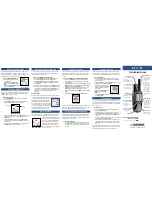
MM-014716-001
81
10.5 RECEIVING A CALL
1.
Turn the radio on by rotating the
POWER ON-OFF/VOLUME
knob clockwise (out of detent). A
short alert signal (if enabled through programming) indicates the radio is ready to use.
2.
Adjust the
POWER ON-OFF/VOLUME
knob to the desired volume level.
3.
Select the desired conventional system and channel. The display indicates the current conventional
system and channel names.
4.
The radio is now ready to receive calls.
5.
When the radio receives a call (and the correct encoding is decoded, if programmed and enabled), it
unmutes on the channel and the
BSY
indicator comes on.
10.6 SENDING A CALL
1.
Turn ON the radio and set the
POWER ON-OFF/VOLUME
knob to the desired volume level.
Select the desired conventional system and channel.
2.
Ensure that the channel is not busy by pressing the
CLR
button to briefly disable any channel
decoding and unmute the receiver or observe the unlit
BSY
indicator. If the Channel Busy Lockout
feature is programmed for the selected channel, the radio will not transmit when the channel is busy.
3.
Press and hold the PTT button. The
TX
indicator will turn on and a short beep sounds (if
programmed) indicating that communication can begin.
4.
Hold the microphone approximately 1 ½ inches from the mouth and speak in a normal voice.
5.
Release the PTT button when the transmission is complete and listen for a reply.
10.7 EMERGENCY OPERATION
If enabled, G-STAR emergency signaling can be transmitted when operating in the conventional mode.
This G-STAR signaling will transmit 5 times with a delay between each transmission. To send an
emergency call on the selected conventional system and channel (or on an optionally pre-programmed
conventional emergency system and channel), proceed as follows:
Press and hold the red
Emergency button for approximately one second (this time is programmable and,
therefore, could be longer or shorter; check with the system administrator). The radio turns on the
TX
indicator and proceeds to transmit the pre-programmed G-STAR emergency signaling sequence.
G-STAR is programmed to transmit in one of the following methods:
METHOD 1:
G-STAR is transmitted on the selected channel. If the channel is changed the emergency
signaling will continue to be transmitted on the newly selected channel.
METHOD 2:
Same as METHOD 1 but the radio will lock on to the currently selected channel. Any
attempts to change the system or channel will be disabled.
METHOD 3:
G-STAR is transmitted on a pre-programmed conventional emergency system and
channel regardless of the selected channel. In this case the selected channel is available
for voice transmission and the radio will periodically change to the pre-programmed
emergency system and channel to send the emergency signaling and then change back to
the selected channel.
METHOD 4:
Same as METHOD 3, but the radio will lock on to the pre-programmed emergency
system and channel. Any attempts to change the system or channel will be disabled.
The emergency state can be cleared by turning the radio OFF and then back ON.
Содержание M/A-COM
Страница 1: ...Operator s Manual MM 014716 001 Jun 08 M A COM M7300 Series Digital Mobile Radio...
Страница 99: ...MM 014716 001 99 SYSTEM NUMBER SYSTEM NAME TRK CNV GRP CHN NUMBER GRP CHN NAME USE...
Страница 100: ...MM 014716 001 100 SYSTEM NUMBER SYSTEM NAME TRK CNV GRP CHN NUMBER GRP CHN NAME USE...
Страница 101: ...MM 014716 001 101 SYSTEM NUMBER SYSTEM NAME TRK CNV GRP CHN NUMBER GRP CHN NAME USE...
Страница 103: ...MM 014716 001 103 This page intentionally left blank...
















































